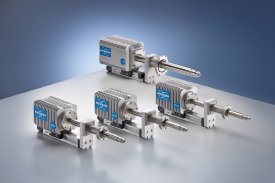Aug 6 2008
Bruker AXS Microanalysis presents the XFlash® 5000 series of liquid nitrogen free XFlash® silicon drift detectors (SDD) for use with its QUANTAX microanalysis systems. These new detectors boast even further improved energy resolutions down to 123 eV at Mn-Ka and 100,000 cps input count rate. All detectors are equipped with an optimized electron trap, which supports interference-free x-ray detection, even at very low excitation energies. The new XFlash® 5000 family consists of 3 members:

The XFlash® 5010 is a 10 mm² detector that that provides superior light element performance. With 123 eV at Mn-Ka it offers an energy resolution of 46 eV at C Ka and 54 eV at F Ka. This allows for a peak resolution in the energy range below 1 keV that is unprecedented for an energy-dispersive detector. QUANTAX’ most comprehensive atomic database – that also contains N-lines – ensures correct identification of elements measured in that range.
The second member of the family is the XFlash® 5030 detector, which contains a 30 mm² SDD chip in a detector endcap that is no wider than that of the XFlash® 5010. The 5030 detector can therefore be used at very short detector to sample distances, providing optimized solid angle for applications with low X-ray quantum yield. This XFlash® 5030 is the detector of choice for use with cold field emission SEMs and TEMs.
Bruker’s XFlash® QUAD 5040 detector is the third family member. This four channel detector, with four 10 mm² sensors integrated on a single chip, provides four times the count rate of a single 10 mm² detector at an energy resolution of 123 eV at Mn-Ka. The QUAD is equally suitable for measurements at low and high count rates. With a maximum input count rate capability of well beyond 3,000,000 cps it is suitable for use on microprobes during normal operation. It expands the area of application for these instruments to simultaneous multi-element analysis, fast mapping and spectral imaging at low to medium magnifications and analyses of rough samples and particles.
For more information on microanalysis, click here.